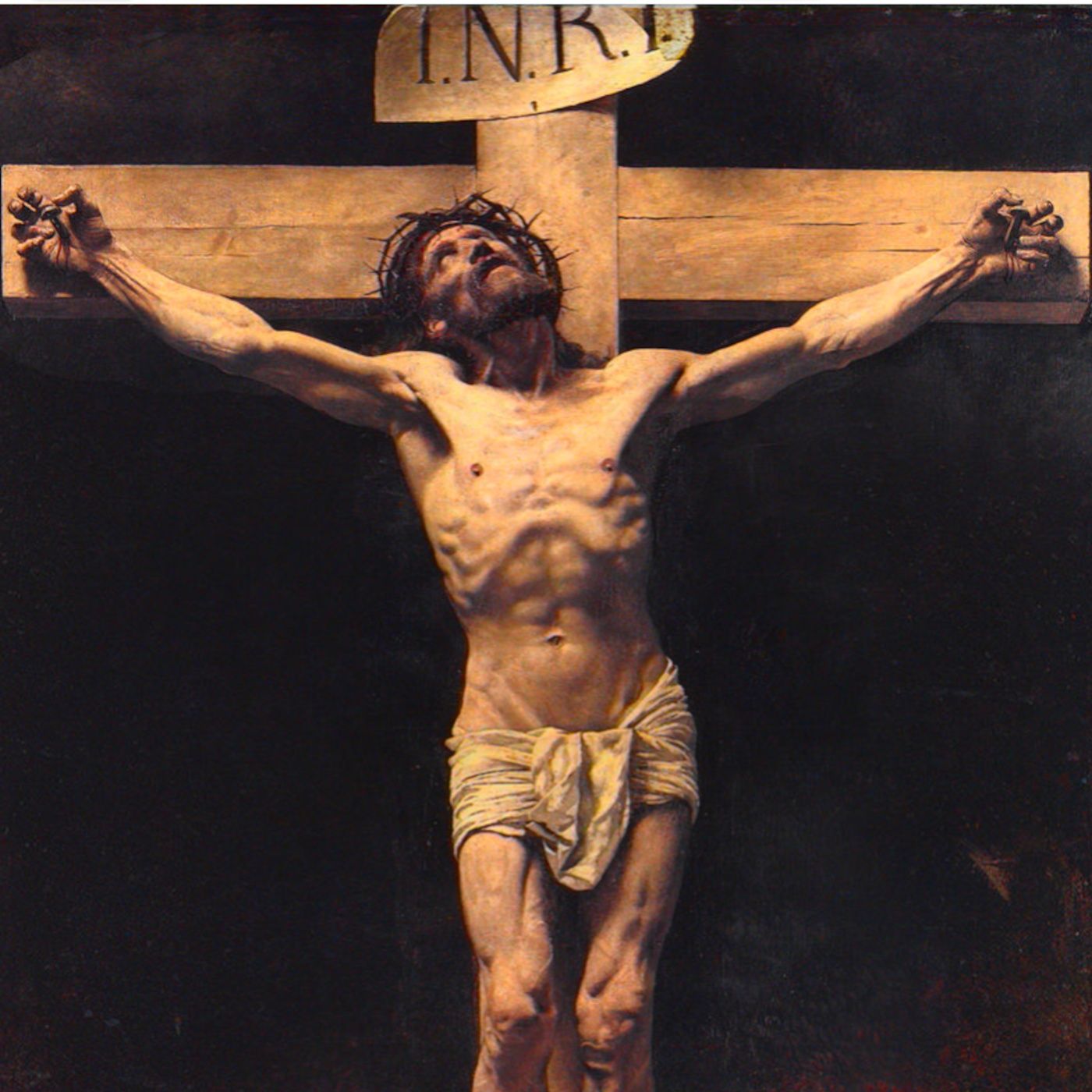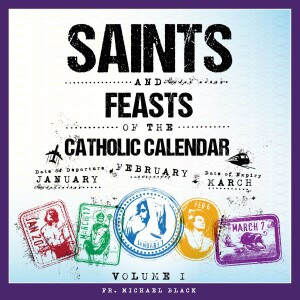
Friday of the Passion of the Lord (Good Friday)
 2024-03-29
2024-03-29
Download
Right click and do "save link as"
Friday of the Passion of the Lord (Good Friday)
c. 33 A.D.
Triduum; Liturgical Color: Red
No one knew love looked like this
One of the most famous Greek sculptures in the world, a larger-than-life marble statue of a female, reigns over a monumental staircase in the Louvre. A soft, unfelt breeze ripples through the thin, flowing sheets that wrap her frame. Two expansive, articulated wings sweep elegantly back from her torso, giving the impression that she has just floated down from on high and landed softly on the prow of an invisible ship. Though now headless, the statue’s sense of movement is so vivid that one can still “see” her neck craning, her jaw jutting, and her eyes looking carefully downward as she settles to ground. She moves and yet she is still. She is “Winged Victory,” Nike, the Greek goddess of victory.
Victory in battle, conquest in war, and success in sport are typically celebrated with a blast of trumpets, gold medals hung around the neck, ticker-tape parades, a crowning with laurels, or the placing of an elegant statue like “Winged Victory” to serenely personify triumph over one’s enemies. Jesus Christ changed all that. He changed what victory looked like. Jesus climbed a different podium to win a different type of victory over man’s greatest enemy.
On Good Friday, the God of the Living descended into the depths of human experience to conquer death. His victory parade was the carrying of the Cross on His tender shoulders up the hill of Calvary, where His hands were nailed to a splintery timber. He was raised on high by centurions for mockery, not exaltation. He then died a slow, agonizing death as His thorax sunk lower and lower and His diaphragm sucked less and less air into His lungs. It was not fast and clean. It took three hours. No one knew it at the time, but this was the new look of love in the Christian age, this was the new victory pose. Not laurels, but thorns. Not trumpets, but screams. Not medals, but scars. On Good Friday, Christ redefined victory. The victor is not prideful or strong, but humble, meek, wrecked, injured, and dead. Pain in the non-Christian world, whether in the past or today, has no redemptive power or reward. It is just mindless and arbitrary suffering. At best, it is stoicism.
In the person of Jesus Christ, God does not explain human suffering. Instead, He gives it meaning. And giving meaning to something is a type of answer, although not a solution. We do not go to a funeral to solve a problem. We go simply to be present, to share the family’s sorrow. Sharing is a powerful response. It is more satisfying and profound to give something meaning than to make it disappear. The answer of Jesus Christ to human suffering is to share it. His answer is empathy. He suffers, dies, and is buried. No one can point a finger at God and say, “You don’t know what it’s like!” He certainly does know what it’s like! Jesus could have saved the world by cutting Himself shaving. But He didn’t. He experienced more than was necessary, because it was more fitting that God share every single human experience except sin. God drinks the common cup of human suffering to the dregs.
Jesus did not die full of years. He died young, like many tragic heroes. Christ’s death gives hope to all who are preyed upon by loneliness, depression, fear, illness, anxiety, confusion, sin, and shame. In His death, Jesus does not just tell us but shows us that all these things can be conquered when united to Him. Jesus did not leave us a book but a life. And that life continues to be shared with us in word and sacrament, in its fullness, in the Catholic Church.
God did not die on the Cross so that artists could sculpt Him. God died for a higher reason. He died for us. In Christ, the gift and the giver, the priest and the sacrifice, merge, and the result is life. As in marriage, so also in the Trinity, self-gift merges in generative love and creates life. So we etch that powerful reminder of Christ’s life-generating gift of self—the Crucifix—into our tombstones and place it high in our churches. This universal symbol of redemptive love even hangs from fine chains on our necks. In hoc signo vinces. Christ is our new winged Victory, not with two glorious wings spreading out in a proud gesture of triumph, but with His two thin bloody arms pinned to the Cross. He hangs there in agony, gasping for air, and heroically waits for Sunday to come.
Crucified Lord, in Your passion and death, You walked for us the hard path to new life. You exited life through the door of death and so give us hope that the end is the beginning, that loss is gain, that defeat is victory, and that death is life.
view more
c. 33 A.D.
Triduum; Liturgical Color: Red
No one knew love looked like this
One of the most famous Greek sculptures in the world, a larger-than-life marble statue of a female, reigns over a monumental staircase in the Louvre. A soft, unfelt breeze ripples through the thin, flowing sheets that wrap her frame. Two expansive, articulated wings sweep elegantly back from her torso, giving the impression that she has just floated down from on high and landed softly on the prow of an invisible ship. Though now headless, the statue’s sense of movement is so vivid that one can still “see” her neck craning, her jaw jutting, and her eyes looking carefully downward as she settles to ground. She moves and yet she is still. She is “Winged Victory,” Nike, the Greek goddess of victory.
Victory in battle, conquest in war, and success in sport are typically celebrated with a blast of trumpets, gold medals hung around the neck, ticker-tape parades, a crowning with laurels, or the placing of an elegant statue like “Winged Victory” to serenely personify triumph over one’s enemies. Jesus Christ changed all that. He changed what victory looked like. Jesus climbed a different podium to win a different type of victory over man’s greatest enemy.
On Good Friday, the God of the Living descended into the depths of human experience to conquer death. His victory parade was the carrying of the Cross on His tender shoulders up the hill of Calvary, where His hands were nailed to a splintery timber. He was raised on high by centurions for mockery, not exaltation. He then died a slow, agonizing death as His thorax sunk lower and lower and His diaphragm sucked less and less air into His lungs. It was not fast and clean. It took three hours. No one knew it at the time, but this was the new look of love in the Christian age, this was the new victory pose. Not laurels, but thorns. Not trumpets, but screams. Not medals, but scars. On Good Friday, Christ redefined victory. The victor is not prideful or strong, but humble, meek, wrecked, injured, and dead. Pain in the non-Christian world, whether in the past or today, has no redemptive power or reward. It is just mindless and arbitrary suffering. At best, it is stoicism.
In the person of Jesus Christ, God does not explain human suffering. Instead, He gives it meaning. And giving meaning to something is a type of answer, although not a solution. We do not go to a funeral to solve a problem. We go simply to be present, to share the family’s sorrow. Sharing is a powerful response. It is more satisfying and profound to give something meaning than to make it disappear. The answer of Jesus Christ to human suffering is to share it. His answer is empathy. He suffers, dies, and is buried. No one can point a finger at God and say, “You don’t know what it’s like!” He certainly does know what it’s like! Jesus could have saved the world by cutting Himself shaving. But He didn’t. He experienced more than was necessary, because it was more fitting that God share every single human experience except sin. God drinks the common cup of human suffering to the dregs.
Jesus did not die full of years. He died young, like many tragic heroes. Christ’s death gives hope to all who are preyed upon by loneliness, depression, fear, illness, anxiety, confusion, sin, and shame. In His death, Jesus does not just tell us but shows us that all these things can be conquered when united to Him. Jesus did not leave us a book but a life. And that life continues to be shared with us in word and sacrament, in its fullness, in the Catholic Church.
God did not die on the Cross so that artists could sculpt Him. God died for a higher reason. He died for us. In Christ, the gift and the giver, the priest and the sacrifice, merge, and the result is life. As in marriage, so also in the Trinity, self-gift merges in generative love and creates life. So we etch that powerful reminder of Christ’s life-generating gift of self—the Crucifix—into our tombstones and place it high in our churches. This universal symbol of redemptive love even hangs from fine chains on our necks. In hoc signo vinces. Christ is our new winged Victory, not with two glorious wings spreading out in a proud gesture of triumph, but with His two thin bloody arms pinned to the Cross. He hangs there in agony, gasping for air, and heroically waits for Sunday to come.
Crucified Lord, in Your passion and death, You walked for us the hard path to new life. You exited life through the door of death and so give us hope that the end is the beginning, that loss is gain, that defeat is victory, and that death is life.
More Episodes
October 9: Saint John Leonardi, Priest
 2024-10-07
2024-10-07
 2024-10-07
2024-10-07
October 7: Our Lady of the Rosary
 2024-10-06
2024-10-06
 2024-10-06
2024-10-06
October 6: Saint Bruno, Priest
 2024-10-05
2024-10-05
 2024-10-05
2024-10-05
October 5: Saint Faustina Kowalska, Virgin
 2024-10-04
2024-10-04
 2024-10-04
2024-10-04
October 4: Saint Francis of Assisi
 2024-10-02
2024-10-02
 2024-10-02
2024-10-02
October 2: The Holy Guardian Angels
 2024-10-01
2024-10-01
 2024-10-01
2024-10-01
September 28: Saint Wenceslaus, Martyr
 2024-09-28
2024-09-28
 2024-09-28
2024-09-28
September 27: Saint Vincent de Paul, Priest
 2024-09-27
2024-09-27
 2024-09-27
2024-09-27
012345678910111213141516171819
Create your
podcast in
minutes
- Full-featured podcast site
- Unlimited storage and bandwidth
- Comprehensive podcast stats
- Distribute to Apple Podcasts, Spotify, and more
- Make money with your podcast
It is Free
- Privacy Policy
- Cookie Policy
- Terms of Use
- Consent Preferences
- Copyright © 2015-2024 Podbean.com





